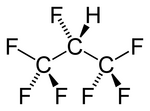1,1,1,2,3,3,3-Heptafluoropropane
This article needs additional citations for verification. (April 2012) |

| |

| |
| Names | |
|---|---|
| IUPAC name
1,1,1,2,3,3,3-Heptafluoropropane
| |
| Other names
Heptafluoropropane
Apaflurane HFC-227ea R-227ea HFC-227 | |
| Identifiers | |
3D model (JSmol)
|
|
| ChEMBL | |
| ChemSpider | |
| ECHA InfoCard | 100.006.437 |
PubChem CID
|
|
| UNII | |
| UN number | UN3296 |
CompTox Dashboard (EPA)
|
|
| |
| |
| Properties | |
| C3HF7 | |
| Molar mass | 170.03 g/mol |
| Density | 1.46 g/cm3 at -16 °C |
| Melting point | −131 °C (−204 °F; 142 K) |
| Boiling point | −16.4 °C (2.5 °F; 256.8 K) |
| Hazards | |
| NFPA 704 (fire diamond) | |
| Related compounds | |
Related compounds
|
1,1,1,2,2,3,3-Heptachloropropane |
Except where otherwise noted, data are given for materials in their standard state (at 25 °C [77 °F], 100 kPa).
| |
1,1,1,2,3,3,3-Heptafluoropropane, also called heptafluoropropane, HFC-227 or HFC-227ea (ISO name), as well as apaflurane (INN), is a colourless, odourless gaseous halocarbon commonly used as a gaseous fire suppression agent.
Chemistry
Its chemical formula is Template:CarbonTemplate:Fluorine3-CTemplate:HydrogenF-CF3, or C3HF7. With a boiling point of -16.4 °C, it is a gas at room temperature. It is slightly soluble in water (260 mg/L).
Use
HFC-227ea finds use in fire suppression systems in data processing and telecommunication facilities, and in protection of many flammable liquids and gases. HFC-227ea falls in the category of Clean Agents and is governed by NFPA 2001 - Standard for Clean Agent Fire Extinguishing Systems. Effective fire suppression requires introducing a concentration of the HFC-227ea agent between 6.25% and 9% depending on the hazard being protected. Its NOAEL level for cardiac sensitization is 9%. The United States Environmental Protection Agency allows concentration of 9% volume in occupied spaces without mandated egress time, or up to 10.5% for a limited time. Most fire suppression systems are designed to provide concentration of 6.25-9%.
The HFC-227ea fire suppression agent was the first non-ozone depleting replacement for Halon 1301.[citation needed] In addition, HFC-227ea leaves no residue on valuable equipment after discharge.[2]
HFC-227ea contains no chlorine or bromine atoms, presenting no ozone depletion effect. Its atmospheric lifetime is approximated between 31 and 42 years. It leaves no residue or oily deposits and can be removed by ventilation of the affected space.
As an aerosol propellant, HFC-227ea is used in pharmaceutical metered dose inhalers such as those used for dispensing asthma medication.
Safety
At high temperatures, heptafluoropropane will decompose and produce hydrogen fluoride. This is observable as presence of sharp, pungent odour, which can be perceived in concentrations far below a dangerous level. Other decomposition products include carbonyl fluoride, carbon monoxide and carbon dioxide. Prior to re-entry of a room where HFC-227ea system has been activated to suppress a fire, the atmosphere should be tested. An Acid Scavenging Additive added to heptafluoropropane is able to reduce the amount of hydrogen fluoride. Contact with liquid HFC-227ea may cause frostbite.
Tradenames for HFC-227ea used as fire suppression agent
- FE-227 FM-200 (Dupont)
- Solkaflam 227 (Solvay Fluor)
- MH-227 (Shanghai Waysmos)
See also
Other fire suppression agents:
References
- Sinerji Fire Protection Product Page (Archived 2009-04-25)

